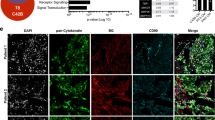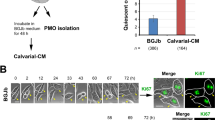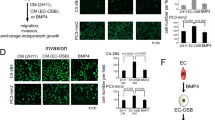Abstract
Background:
Patients with advanced prostate cancer frequently have a poor prognosis as a result of metastasis and present with high serum PSA levels. There is evidence suggesting that the serine protease activity of PSA could be involved in the invasion and metastasis of prostate cancer. In this study, we determined the effects of PSA and its precursor, pro-PSA, on invasion and the type of bone metastasis.
Methods:
We stably transfected prostate adenocarcinoma cells, human DU-145 and rat MatLyLu, with either the full-length prepro-PSA sequence or pre-PSA DNA, to generate subclones of cells that secrete pro-PSA or free PSA, respectively. Secretion of PSA was measured by western blot analysis and enzyme-linked immunosorbent assay (ELISA). The invasive and migratory properties of the cells were determined using a basement membrane extract and were compared with corresponding empty vector control cells. Twelve days after injection of PSA-secreting MatLyLu cells into the femora of nude mice, bone tumor burden and histomorphometry were determined using a stereological technique.
Results:
The transfected cells secreted 0.15–2.23 ng PSA/106 cells/day. Pro-PSA-secreting subclones increased invasion and migration by 24–263%. Conversely, the PSA-secreting subclones significantly reduced both invasion and migration by 59–70%. The divergent effects on invasion and migration observed in pro-PSA- and PSA-secreting subclones indicate that different forms of PSA may have different functions. Intrafemoral injections with PSA-secreting MatLyLu cells resulted in an increase in osteoblastic parameters when compared with non-PSA-secreting subclones as measured by bone histomorphometry. Concomitantly, a decrease in osteoclasts and eroded surface was observed.
Conclusions:
Our in vitro data suggest that PSA, dependent on the predominant form secreted, may decrease or increase invasive properties of prostate cancer cells. The in vivo results indicate that PSA in the bone microenvironment may contribute to the osteoblastic phenotype of bone metastasis frequently observed in prostate cancer.
This is a preview of subscription content, access via your institution
Access options
Subscribe to this journal
Receive 4 print issues and online access
$259.00 per year
only $64.75 per issue
Buy this article
- Purchase on Springer Link
- Instant access to full article PDF
Prices may be subject to local taxes which are calculated during checkout





Similar content being viewed by others
References
Ries LAG, Eisner MP, Kosary CL, Hankey BF, Miller BA, Clegg L et al. SEER Cancer Statistics Review, 1975–2002. National Cancer Institute: Bethesda, MD, 2004. http://seer.cancer.gov/csr/1975_2002.
Vihinen P, Kahari VM . Matrix metalloproteinases in cancer: prognostic markers and therapeutic targets. Int J Cancer 2002; 99: 157–166.
Webber MM, Waghray A, Bello D . Prostate-specific antigen, a serine protease, facilitates human prostate cancer cell invasion. Clin Cancer Res 1995; 1: 1089–1094.
Lilja H . A kallikrein-like serine protease in prostatic fluid cleaves the predominant seminal vesicle protein. J Clin Invest 1985; 76: 1899–1903.
Malm J, Hellman J, Hogg P, Lilja H . Enzymatic action of prostate-specific antigen (PSA or hK3): substrate specificity and regulation by Zn(2+), a tight-binding inhibitor. Prostate 2000; 45: 132–139.
Robert M, Gagnon C . Semenogelin I: a coagulum forming, multifunctional seminal vesicle protein. Cell Mol Life Sci 1999; 55: 944–960.
Gjertson CK, Albertsen PC . Use and assessment of PSA in prostate cancer. Med Clin North Am 2010; 95: 191–200.
Lövgren J, Rajakoski K, Karp M, Lundwall A, Lilja H . Activation of the zymogen form of prostate-specific antigen by human glandular kallikrein 2. Biochem Biophys Res Commun 1997; 238: 549–555.
Takayama TK, McMullen BA, Nelson PS, Matsumura M, Fujikawa K . Characterization of hK4 (prostase), a prostate-specific serine protease: activation of the precursor of prostate specific antigen (pro-PSA) and single-chain urokinase-type plasminogen activator and degradation of prostatic acid phosphatase. Biochemistry 2001; 40: 15341–15348.
Michael IP, Pampalakis G, Mikolajczyk SD, Malm J, Sotiropoulou G, Diamandis EP . Human tissue kallikrein 5 is a member of a proteolytic cascade pathway involved in seminal clot liquefaction and potentially in prostate cancer progression. J Biol Chem 2006; 281: 12743–12750.
McCormack RT, Rittenhouse HG, Finlay JA, Sokoloff RL, Wang TJ, Wolfert RL et al. Molecular forms of prostate-specific antigen and the human kallikrein gene family: a new era. Urology 1995; 45: 729–744.
Mikolajczyk SD, Millar LS, Marker KM, Wang TJ, Rittenhouse HG, Marks LS et al. Seminal plasma contains ″BPSA,″ a molecular form of prostate-specific antigen that is associated with benign prostatic hyperplasia. Prostate 2000; 45: 271–276.
Mikolajczyk SD, Rittenhouse HG . Pro PSA: a more cancer specific form of prostate specific antigen for the early detection of prostate cancer. Keio J Med 2003; 52: 86–91.
Niemelä P, Lövgren J, Karp M, Lilja H, Pettersson K . Sensitive and specific enzymatic assay for the determination of precursor forms of prostate-specific antigen after an activation step. Clin Chem 2002; 48: 1257–1264.
Parwani AV, Marlow C, Demarzo AM, Mikolajczyk SD, Rittenhouse HG, Veltri RW et al. Immunohistochemical staining of precursor forms of prostate-specific antigen (proPSA) in metastatic prostate cancer. Am J Surg Pathol 2006; 30: 1231–1236.
Réhault S, Monget P, Mazerbourg S, Tremblay R, Gutman N, Gauthier F et al. Insulin-like growth factor binding proteins (IGFBPs) as potential physiological substrates for human kallikreins hK2 and hK3. Eur J Biochem 2001; 268: 2960–2968.
Cramer SD, Chen Z, Peehl DM . Prostate specific antigen cleaves parathyroid hormone-related protein in the PTH-like domain: Inactivation of PTHrP-stimulated cAMP accumulation in mouse osteoblasts. J Urol 1996; 156: 526–531.
Dallas SL, Zhao S, Cramer SD, Chen Z, Peehl DM, Bonewald LF . Preferential production of latent transforming growth factor beta-2 by primary prostatic epithelial cells and its activation by prostate-specific antigen. J Cell Physiol 2005; 202: 361–370.
Vukmirovic-Popovic S, Escott NG, Duivenvoorden WC . Presence and enzymatic activity of prostate-specific antigen in archival prostate cancer samples. Oncol Rep 2008; 20: 897–903.
Duivenvoorden WCM, Vukmirovic-Popovic S, Lhotak S, Seidlitz E, Hirte HW, Tozer RG et al. Doxycycline decreases tumor burden in a bone metastasis model of human breast cancer. Cancer Res 2002; 62: 1588–1591.
Lhotak S, Elavathil LJ, Vukmirovic-Popovic S, Duivenvoorden WC, Tozer RG, Singh G . Immunolocalization of matrix metalloproteinases and their inhibitors in clinical specimens of bone metastasis from breast carcinoma. Clin Exp Metastasis 2001; 18: 463–470.
Lundwall A, Band V, Blaber M, Clements JA, Courty Y, Diamandis EP et al. A comprehensive nomenclature for serine proteases with homology to tissue kallikreins. Biol Chem 2006; 387: 637–641.
Ishii K, Otsuka T, Iguchi K, Usui S, Yamamoto H, Sugimura Y et al. Evidence that the prostate-specific antigen (PSA)/Zn(2+) axis may play a role in human prostate cancer cell invasion. Cancer Lett 2004; 207: 79–87.
Corey E, Brown LG, Corey MJ, Buhler KR, Vessella RL . LNCaP produces both putative zymogen and inactive, free form of prostate-specific antigen. Prostate 1998; 35: 135–143.
Denmeade SR, Sokoll LJ, Chan DW, Khan SR, Isaacs JT . Concentration of enzymatically active prostate-specific antigen (PSA) in the extracellular fluid of primary human prostate cancers and human prostate cancer xenograft models. Prostate 2001; 48: 1–6.
Veveris-Lowe TL, Lawrence MG, Collard RL, Bui L, Herington AC, Nicol DL et al. Kallikrein 4 (hK4) and prostate-specific antigen (PSA) are associated with the loss of E-cadherin and an epithelial-mesenchymal transition (EMT)-like effect in prostate cancer cells. Endocr Relat Cancer 2005; 12: 631–643.
Misra UK, Payne S, Pizzo SV . Ligation of prostate cancer cell surface GRP78 activates a proproliferative and antiapoptotic feedback loop: a role for secreted prostate-specific antigen. J Biol Chem 2011; 286: 1248–1259.
Nadiminty N, Lou W, Lee SO, Mehraein-Ghomi F, Kirk JS, Conroy JM et al. Prostate-specific antigen modulates genes involved in bone remodeling and induces osteoblast differentiation of human osteosarcoma cell line SaOS-2. Clin Cancer Res 2006; 12: 1420–1430.
Powell GJ, Southby J, Danks JA, Stillwell RG, Hayman JA, Henderson MA et al. Localization of parathyroid hormone-related protein in breast cancer metastases: increased incidence in bone compared with other sites. Cancer Res 1991; 51: 3059–3061.
Schmid C, Schlapfer I, Keller A, Waldvogel M, Froesch ER, Zapf J . Effects of insulin-like growth factor (IGF) binding proteins (BPs) -3 and -6 on DNA synthesis of rat osteoblasts: further evidence for a role of auto-/paracrine IGF I but not IGF II in stimulating osteoblast growth. Biochem Biophys Res Commun 1995; 212: 242–248.
Miyakoshi N, Richman C, Qin X, Baylink DJ, Mohan S . Effects of recombinant insulin-like growth factor-binding protein-4 on bone formation parameters in mice. Endocrinology 1999; 140: 5719–5728.
Minuto F, Palermo C, Arvigo M, Barreca AM . The IGF system and bone. J Endocrinol Invest 2005; 28 (8 Suppl): 8–10.
Pfeilschifter J, Seyedin SM, Mundy GR . Transforming growth factor beta inhibits bone resorption in fetal rat long bone cultures. J Clin Invest 1988; 82: 680–685.
Lu L, Yaszemski MJ, Mikos AG . TGF-beta1 release from biodegradable polymer microparticles: its effects on marrow stromal osteoblast function. J Bone Joint Surg Am 2001; 83A (Suppl 1 Pt 2): S82–S91.
Roodman GD . Mechanisms of bone metastasis. N Engl J Med 2004; 350: 1655–1664.
Blomme EAG, Dougherty KM, Pienta KJ, Capen CC, Rosol TJ, McCauley LK . Skeletal metastasis of prostate adenocarcinoma in rats: morphometric analysis and role of parathyroid hormone-related protein. Prostate 1999; 39: 187–197.
Urwin GH, Percival RC, Beneton MNC, Williams JL, Kanis JA . Generalised increase in bone resorption in carcinoma of the prostate. Br J Urol 1985; 57: 721–723.
Leinonen J, Zhang WM, Stenman UH . Complex formation between PSA isoenzymes and protease inhibitors. J Urol 1996; 155: 1099–1103.
Acknowledgements
We are indebted to Dr Hans Krause (Charité Universitätsmedizin, Berlin, Germany) who provided the original PSA-constructs, Ms Nicole Simunovic for excellent technical assistance and Dr Gurmit Singh for use of the animal quarters and helpful discussions. This study was supported by the Canadian Institutes of Health Research (#67201) and Prostate Cancer Canada.
Author information
Authors and Affiliations
Corresponding author
Ethics declarations
Competing interests
The authors declare no conflict of interest.
Rights and permissions
About this article
Cite this article
Cumming, A., Hopmans, S., Vukmirović-Popović, S. et al. PSA affects prostate cancer cell invasion in vitro and induces an osteoblastic phenotype in bone in vivo. Prostate Cancer Prostatic Dis 14, 286–294 (2011). https://doi.org/10.1038/pcan.2011.34
Received:
Revised:
Accepted:
Published:
Issue Date:
DOI: https://doi.org/10.1038/pcan.2011.34
Keywords
This article is cited by
-
Beyond the biomarker role: prostate-specific antigen (PSA) in the prostate cancer microenvironment
Cancer and Metastasis Reviews (2019)
-
Cysteine-rich secretory protein 3 plays a role in prostate cancer cell invasion and affects expression of PSA and ANXA1
Molecular and Cellular Biochemistry (2016)
-
Underactivation of the adiponectin–adiponectin receptor 1 axis in clear cell renal cell carcinoma: implications for progression
Clinical & Experimental Metastasis (2014)



